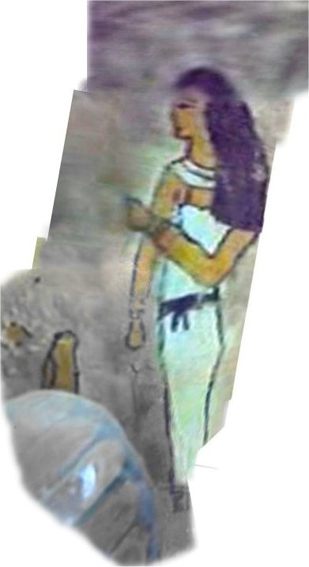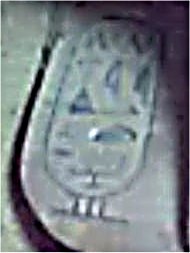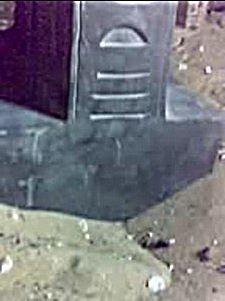![]()
GIZA
TRAGEDY EXPOSES
BLACK MARKET TRADE
ILLEGAL DIGGINGS AT GIZA REVEAL THE BIZARRE AND CHILLING LENGTHS THAT RESIDENTS GO TO FEED THE BLACK MARKET WITH GENUINE AND FAKE ANTIQUITIES
A
REPORT BY ANDREW COLLINS, MARCH 18, 2010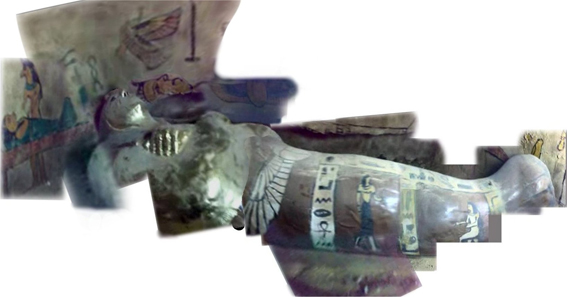
Composite
image of the mummiform coffin found inside the "tomb" chamber revealed
in the
video phone recording. The distortion of the head is due to the angle
at which the face area was originally recorded(pic credit: Rodney Hale, 2010)
In September last year I reported on the deaths of six individuals following the collapse of illegal tomb digging beneath a building in Nazlet el-Samman, the village of the pyramids located just beyond the Sphinx entrance to the plateau. The tragedy alerted both the antiquities police and the Supreme Council of Antiquities (SCA) to what was going on, leading to the seizure of various valuable objects supposedly found during the illegal excavations, and the arrest of those seemingly behind these nefarious activities.
Even
before confirmation of this unfortunate incident, so close to the world-famous
pyramid field, rumours began circulating of phone videos allegedly showing some
of the "antiquities" found during the illicit excavations.
The
Phone Video Revealed
I can now reveal that in January I was given one of the phone videos by a contact in the United States, who obtained it from a resident in the village. At five minutes, 22 seconds in length, it shows a video phone being used to record the descent of the holder into a rock-cut shaft that ends in a sand-filled pit, from which access is gained - via a rectangular opening - to a small rectangular "tomb" chamber. The shaky video, which is of poor quality, then pans around to reveal walls covered in ancient Egyptian-style painted decoration. These include lines of seated deities, a jackal-headed figure leaning over a mummiform coffin on a bier, a winged sun disk, and various hieroglyphic images.
Standing
on the sandy floor we see three large stone statues, with lines of hieroglyphs
running down their backs. One of these statues only just fits into the low room.
Finally, up against the edge of one wall, the phone video focuses on a
mummiform coffin, much of the head and shoulder area covered in gilt. Behind this
is a breached hole in the wall revealing a long recess that might once have contained
the coffin. Immediately above this breach is another painted image, this time
of a mummiform coffin, seemingly the one in the video.
The holder of the video phone is seen approaching each one of the statues in turn. As he reaches them, a hand is seen placing a string of religious beads around the statue's neck. He also places the beads on the gilted face of the anthropoid coffin. Why someone should want to carry out this apparently superstitious act is open to speculation. Presumably the beads are being used to bless the statues in the hope that this will protect the intruder from any malign influences seen to be attached to both the statues and the coffin case. Chillingly, it is alleged that the phone video was taken by one of the six people subsequently killed when the collapse took place, even though there is no clue in the video itself as to where exactly the tomb might be located.
To
view the actual video - click the YouTube link below:
Since receiving the video footage back in January, I have spent some time attempting to understand what exactly it shows. From the outset I was suspicious of the painted wall decoration, which seems too crude to be of ancient Egyptian manufacture. I asked technical engineer Rodney Hale to examine the visual evidence and see what he could find. He used a sequence of stills taken from the video to recreate the approximate "tomb" layout, the images on the walls, along with the three statues and their respective hieroglyphic inscriptions (all these are to be found at the base of this report).
Hieroglyphic
Hoax
Hale's photo montages reveal that the wall decoration is almost certainly of modern manufacture. As regards the statues, although they might look genuine, their hieroglyphs are all over the place, without any kind of conformity indicating that the inscriptions are confabulations without any real meaning.
One
of the statues bears a cartouche with hieroglyphs that crudely spells the name
"Maat-ka-re", the throne name of Hatshepsut, the well-known female pharaoh
who ruled during Egypt's New Kingdom, some 3,500 years ago. However, the seated
figure representing the hieroglyph maat, the principle of truth and cosmic
order, is drawn wrongly, making nonsense of the name. Rumours circulating Nazlet
had already suggested that one or more of the antiquities "discovered"
in the tomb bore Queen Hatshepsut's cartouche, she being one of the most popular
rulers of ancient Egypt.
False
Coffins If the statues and wall decoration are modern creations, then where does this leave the gilted mummiform coffin? Unfortunately, this too is likely to be a modern confabulation; the whole burial being created and videoed in order to give the impression of a previously unexplored tomb. A second video not seen by the author shows another mummiform coffin, this one decorated with the image of a crocodile on the back of a hippo. These zoomorphic figures, shown together in funerary reliefs during the New Kingdom period, are most probably of astronomical significance, and may represent the constellation of Draco, which marked the north celestial pole at the beginning of the Pyramid Age. However, this second mummy case is also very likely to be of modern manufacture. |
Composite image showing a female figure forming part of the wall decoration inside the "tomb". The crudeness belies its modern manufacture (pic credit: Rodney Hale, 2010). |
As for the tomb seen in the phone video, this would seem to be a real rock-cut chamber existing at the bottom of a vertical shaft of dynastic origin. In the video a second rectangular opening can be seen next to the one leading into the burial chamber, suggesting that there are other stone chambers to be explored. Its entrance is blocked with a very large stone slab typical of ancient Egyptian funerary architecture. Whether any original wall paintings existed in the chamber prior to its redecoration remains to be seen.
What we do know is that the building said to mark the entrance into the illegal diggings has now been demolished, along with others in the immediate vicinity. This was done presumably to, firstly, stop any more structural collapses and, secondly, to search for further evidence of dynastic activity. From what I understand the site in question is a few hundred metres north of the Sphinx monument, just beyond the concrete and metal wall erected between the edge of the village and the start of the pyramid field.
Selling
to the Black Market
And the purpose of this elaborate and very tragic
hoax? The phone videos were almost certainly made to ensnare would-be buyers of
Egyptian antiquities. Anyone interested in buying high quality antiquities would
have been shown the video, and told that priceless items removed from this newly
discovered tomb were now available for purchase.
On the black market, genuine pharaonic statues of the size and apparent quality of those seen in the video are worth somewhere in the region of between three to five million dollars, a powerful enough motive to create such an elaborate hoax. Any would-be buyer of antiquities in this manner is unlikely to have taken the phone video to a bonafide Egyptologist for them to pass comment, meaning that they could easily have been duped into believing that they were seeing the contents of a genuine tomb.
Ironically, I am told that those responsible for the sale of Egyptian antiquities on the black market mix genuine items with modern fakes, generating even more confusion in the process. On top of this is the claim made to me that although the phone video is a hoax, the illegal diggings were themselves real and produced a number of genuine artefacts that were spirited away before the police and SCA arrived on the scene. Many of these near priceless objects will already have been sold to the highest bidder. Even more bizarre are claims that, despite the tragedy of the six deaths, and the incarceration of various individuals, the illegal diggings in Nazlet el-Samman go on. Yes, they are doing it again now, at new sites in the same general area. It would seem that the trade in antiquities, whether genuine or fake, is so lucrative that these people simply cannot leave it alone.
Any further developments in this extraordinary saga will be brought to you as and when they come to light. I am sure that Dr Zahi Hawass, the Secretary General of the SCA, will have something to say about the matter in due course, especially if the individuals arrested are ever brought to trial.
To read the original report of the illegal diggings at Giza, press here.
To
read a follow up report announcing the possible astronomical significance of images
on one of the coffins found in the building in Nazlet el-Samman following the
collapse, press here.
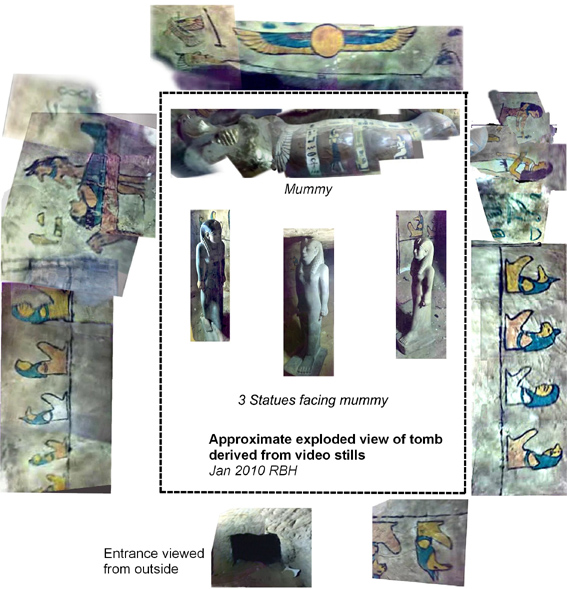
Rodney Hale's reconstruction of the "tomb" layout as created from stills taken from the phone video. The directional orientation is unknown(credit: Rodney Hale).
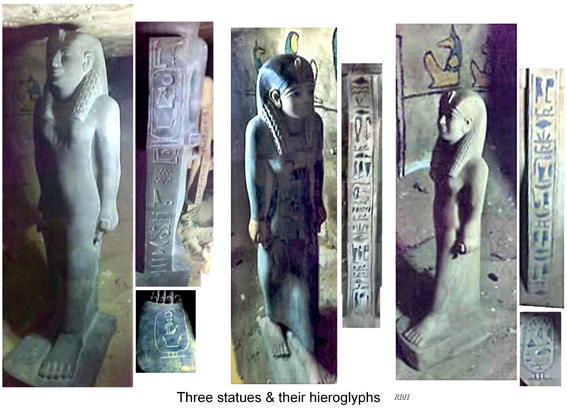
The
three statues seen inside the tomb chamber, complete with their hieroglyphic inscriptions.
We
are happy to receive constructive translations, even though the statues
are
thought to be modern creations (pic credit: Rodney Hale, 2010).
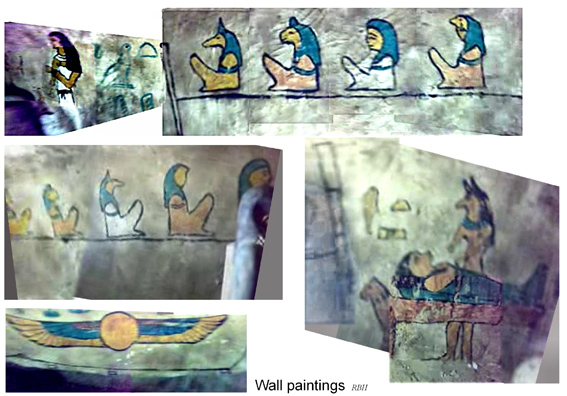
The
various painted images seen on the walls of the tomb chamber. Their crudeness
is obvious,
and tells us immediately they they are likely not to be of pharaonic
origin.
(pic credit: Rodney Hale, 2010)
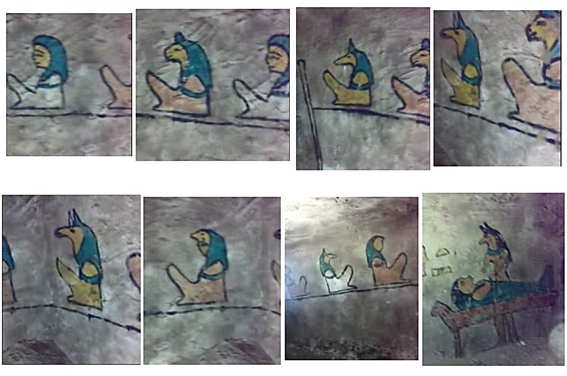
The
rows of seated figures around the walls of the "tomb" chamber
as
seen in the phone video (pic credit: Rodney Hale, 2010).
Cartouche
on the base of one of the statues seen in the phone video. Any attempts at a suitable
translation will be appreciated. |
Hieroglyphs
at the base of one of the statues seen in the phone video. |
![]()
